Most people buy a gun for a reason. Aside from hunting, where it is used to put food on the table, a firearm can be used in shooting sports and as a lifesaving tool for self-defense and protecting others. Such uses can be further partitioned into three categories; to compete, defend or protect.
by Steve Tarani
Although sharing common ground, for example, hitting what you’re aiming at, what are the specifics that delineate each of these uses?
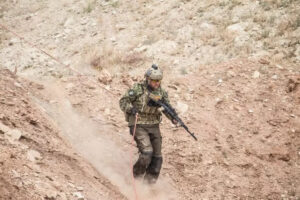
Compete
The National Shooting Sports Foundation (NSSF) states that 19 million-plus Americans safely invest their time in shooting practice. According to NSSF, some of this is for fun, and much of it is for competitive shooting. Some common and familiar examples of competitive shooting are:
Cowboy Action Shooting: The primary requirement for these types of shooting events is that the guns used are from the era of the American cowboy. That typically means from the 1800s. These are perfect events to get a look at antique guns and their usage.
Bullseye Shooting: While this can occur with the use of rifles, it is mostly a long-distance event for pistol shooters. By long-distance, NSSF defines this as upwards of 50 yards. Competitions are usually a mix of slow-firing and rapid-firing contests. A timer might be used to increase the difficulty level, and participants might also be required to fire using a single-hand rather than a double-hand grip.
International Defensive Pistol Association (IDPA) shooting events: This action shooting event focuses on international rules and guns. This shooting competition focuses on self-defense-type shooting situations, and the events mimic real life as much as possible. Its sister competition is the United States Practical Shooting Organization (USPSA), which is the U.S. version.
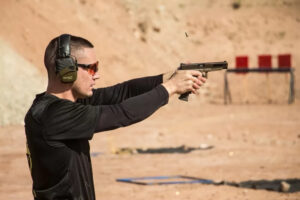
The International Practical Shooting Confederation (IPSC) is one of the world’s largest shooting sports associations and the oldest within practical shooting. Founded in 1976, the IPSC nowadays affiliates over 100 regions from Africa, the Americas, Asia, and Europe.
Regardless of governing body, the firearm, as applied to competition shooting, is used in organized shooting events where competitors shoot in a controlled target shooting environment called ‘stages’ based on rules and regulations of the hosting organization. A stage consists of a designated array of targets set up in such a manner as to challenge the shooters’ skills and understanding of the sport.
As with all shooting sports, safety is the highest priority, and as such, competitors are confined to a180 degree range of fire resulting in disqualification if you break that 180-degree shooting plane. Additionally, competitions run a ‘cold range’ which means you must unload your handgun prior to leaving the firing line.
Competition shooting is a ‘one-way range’ (bullets only go one way – down range) where the shooters square off against targets, control the gun and their movement while being aware of their environment, which is predetermined by target placement. As it is a gaming environment with specific rules, targets, and shooting standards, strategy can be developed ahead of time, such as ‘walking the stage(s),’ knowing the round count, and other gaming considerations. Round placement on targets is scored according to regulations set by a governing entity and results in points either earned or deducted based on the shooter’s performance.
Top-level professional shooters are sponsored by various firearms and/ or ammunition manufacturers and are often referred to as ‘brand ambassadors’ by their sponsors. Competitions are scheduled at the local shooting club level, regionally, nationally, and internationally.
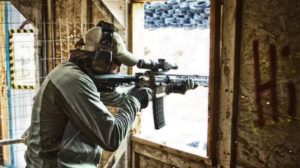
Defend
People who purchase firearms for self-defense are commonly referred to as ‘defensive’ or ‘tactical’ shooters. Military, police, and responsible citizens of a free republic are trained to utilize a handgun in defense against other human beings who may also be armed with a firearm, other ballistic or non-ballistic weapons intent on inflicting great bodily harm or death to the shooter.
Unlike competition shooting, defensive shooting is applied to a 360-degree range of fire referred to as a ‘two-way range’ (bullets flying in both directions – up range and downrange). Defensive shooters are trained to win a gunfight where an active threat is trying to hurt or kill them in a life-or-death situation. Governed by federal and state laws, as opposed to gaming commission rules, it is incumbent upon the defensive shooter to train in the appropriate use of deadly force.
Training levels vary in the defensive shooting world from a novice shooter attending a reputable shooting school on one end of the skills-development spectrum to highly trained tier-1 government (T1G) assets such as military combat specialty unit operations personnel at the opposite end.
Defensive shooters are trained to stop an active threat if they find themselves in a situation where there may be no alternative other than the use of deadly force to solve the tactical problem.
Defensive shooting drills prepare you for a fight for your life. You are trained to control your movement with such tactics as the use of cover, tactical movement, and other defensive options as determined by your environment. There are no stages and no preplanned movement. Defensive shooters often carry concealed and run a ‘hot range’ where their firearm is always loaded.
The highest priority in defensive shooting is to remove yourself from harm’s way and with the least amount of injury possible. There are no rules save appropriate use of force and tactics. The cost of missing your target is not a deduction of points but the very real potential for loss of life.
In defensive shooting, you are legally responsible for every round that departs your muzzle. Because of this, you must be acutely aware of your gun safety, gun handling, and marksmanship in a 360-degree two-way range which may end up being your home, in or around a vehicle, or at an open public venue. Moreover, in any violent physical engagement involving other humans, you are hard-pressed to make combat-effective decisions and round placement on single or multiple active threats while under duress.
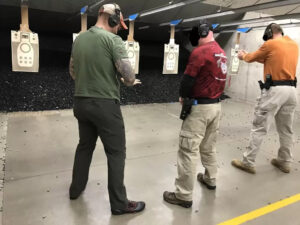
Protect
In the world of professional protective services, shooters are often members of an assigned Protective Services Detail (PSD). However, it should be noted that there’s a distinct difference between ‘bodyguard’ and PSD personnel and that difference is the level of training.
Much like the difference in defensive shooters, where special operations personnel are significantly better trained, PSD shooters are required to go through months of arduous skills development and physical training, whereas a ‘bodyguard’ is not. For example, PSD physical training requirements could include an ability to perform a fireman’s carry, running a timed mile, proficiency in tactical medicine, defensive driving, encrypted communications, multiple weapons systems, and a myriad of other PSD skills requirement.
Examples of the T1G tip of the spear PSD would include the United States Secret Service and the US Department of State Bureau of Diplomatic Security (DS), which is the federal law enforcement and PSD security bureau of the U.S. Department of State.
Much like defensive shooting, PSD shooters are trained to engage in a two-way 360-degree range fighting from a position of dominance (POD). PSD personnel are additionally trained in building and vehicle operations (such as approaches and departures) and to use their environment as a tool to prevail in a violent physical engagement.
Unlike defensive shooting, which emphasizes control of the handgun, PSD demands responsibility and control of three things: your firearm, your protectee, and your environment. Tasked with either stopping or mitigating the threat, a PSD shooter’s highest priority is the safety and well-being of their protectee(s) – even at the expense of taking a bullet for them.
In PSD, the objective is to move off the ‘X’ with the lowest scale of injury to yourself and those you are protecting. PSD personnel are trained to deliver combat-effective round placement in a timely manner to control a life-threatening altercation involving third parties immediately. The price tag for failure is exceptionally high as it could impact multiple persons.
The firearm is considered a lifesaving tool to defensive and PSD shooters. They are trained in gun safety, gun handling, and marksmanship like a competitor. However, unlike a competitor, they are additionally trained in vetted gunfighting tactics and in the specifics of managing a hot range. Defensive and PSD shooters expect to operate under duress on a two-way range and in a 360-degree dynamic high-threat environment while saving lives.
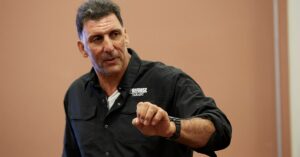
About the Author:
Steve Tarani is a former full-time CIA protective programs employee, small arms and defensive tactics subject matter expert who served on POTUS 45 pre-election executive protection detail. He is the lead instructor for NRA’s non-ballistic weapons training program offered nationally and a widely recognized SME on matters of personal protection and urban survival. Tarani is also a DoD and FLETC-certified federal firearms instructor who has been on staff at Gunsite Academy (AZ) as a Rangemaster for over twenty years. Formerly sworn, he is also a former federal contractor and service provider for the US Defense Intelligence Community, US Naval Special Operations Command, and other government agencies. Additionally, Tarani serves on the National Sheriffs’ Association Committee for School Safety and Security.

